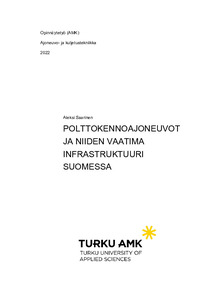Polttokennoajoneuvot ja niiden vaatima infrastruktuuri Suomessa
Saarinen, Aleksi (2022)
Saarinen, Aleksi
2022
Julkaisun pysyvä osoite on
https://urn.fi/URN:NBN:fi:amk-2022061618072
https://urn.fi/URN:NBN:fi:amk-2022061618072
Tiivistelmä
Tämän opinnäytetyön tarkoituksena on selvittää polttokennolla toimivien ajoneuvojen tämänhetkistä tilannetta Suomessa. Tarkoituksena on myös selvittää, mitä vihreän vedyn tuotantolaitosten ja tankkausverkoston rakentaminen sekä ajoneuvojen käyttöönotto vaatii. Työssä selvitetään käyttöönoton vaiheita mm. toimenpiteiden sekä kustannusten osalta.
Alkuun työssä tarkastellaan polttokennoajoneuvojen tekniikkaa, polttokennon toimintaperiaatetta ja sen käyttämää polttoainetta. Polttoaineiden osalta keskitytään tässä työssä vetyyn. Vaikka vety ei ole ainoa mahdollinen polttoaine polttokennolle, se on ympäristöystävällisin, sekä myös yleisin ajoneuvokäytössä. Vedystä selvitetään myös sen hiilineutraalia valmistusprosessia. Tämän lisäksi työssä vertaillaan vetyä muihin yleisimpiin polttoaineisiin.
Tiedonhaussa on käytetty pääosin internetiä ja e-kirjoja lähdemateriaalina. Materiaalia suoraan Suomesta ei paljoa aiheeseen liittyen ole julkaistu, sillä aihe on vielä sen verran tuore.
Polttokennoautojen tulevaisuus on vielä tällä hetkellä hieman epävarma. Täyssähköautojen markkinat ovat viime vuosina kasvaneet niin nopeasti, että ns. tavallinen kuluttaja ei välttämättä edes tiedä muista mahdollisista vaihtoehdoista. The purpose of this thesis is to find out what the current situation of fuel cell vehicles is in Finland. This thesis also investigates the requirements that are needed for refueling stations, vehicles, and facilities to operate.
In the beginning of this work, the focus is to explain what a fuel cell vehicle is, what are its operating principles and what it uses as an energy source. From the fuels that a fuel cell could use for its operation, only hydrogen is being looked up more closely in this work. Even though there are other fuels that could be used, hydrogen is the most nature-friendly fuel as well as currently the most used fuel in fuel cell vehicles. The ways hydrogen can be manufactured carbon free is also something this work focuses on.
This work uses mainly internet and e-books as its sources. Material regarding the topic has not been published that much yet in Finland.
The future of fuel cell vehicles is still uncertain at the moment. Rapid growth of electric car industry in the past few years has been so dominant that a “normal customer” has maybe not even heard about other options.
Alkuun työssä tarkastellaan polttokennoajoneuvojen tekniikkaa, polttokennon toimintaperiaatetta ja sen käyttämää polttoainetta. Polttoaineiden osalta keskitytään tässä työssä vetyyn. Vaikka vety ei ole ainoa mahdollinen polttoaine polttokennolle, se on ympäristöystävällisin, sekä myös yleisin ajoneuvokäytössä. Vedystä selvitetään myös sen hiilineutraalia valmistusprosessia. Tämän lisäksi työssä vertaillaan vetyä muihin yleisimpiin polttoaineisiin.
Tiedonhaussa on käytetty pääosin internetiä ja e-kirjoja lähdemateriaalina. Materiaalia suoraan Suomesta ei paljoa aiheeseen liittyen ole julkaistu, sillä aihe on vielä sen verran tuore.
Polttokennoautojen tulevaisuus on vielä tällä hetkellä hieman epävarma. Täyssähköautojen markkinat ovat viime vuosina kasvaneet niin nopeasti, että ns. tavallinen kuluttaja ei välttämättä edes tiedä muista mahdollisista vaihtoehdoista.
In the beginning of this work, the focus is to explain what a fuel cell vehicle is, what are its operating principles and what it uses as an energy source. From the fuels that a fuel cell could use for its operation, only hydrogen is being looked up more closely in this work. Even though there are other fuels that could be used, hydrogen is the most nature-friendly fuel as well as currently the most used fuel in fuel cell vehicles. The ways hydrogen can be manufactured carbon free is also something this work focuses on.
This work uses mainly internet and e-books as its sources. Material regarding the topic has not been published that much yet in Finland.
The future of fuel cell vehicles is still uncertain at the moment. Rapid growth of electric car industry in the past few years has been so dominant that a “normal customer” has maybe not even heard about other options.
